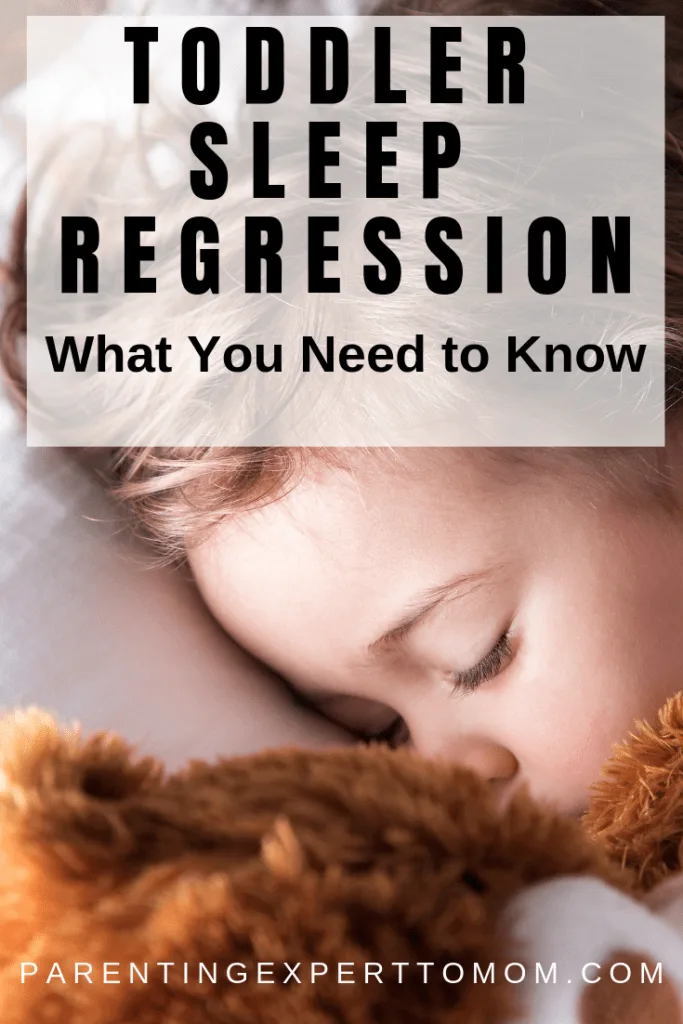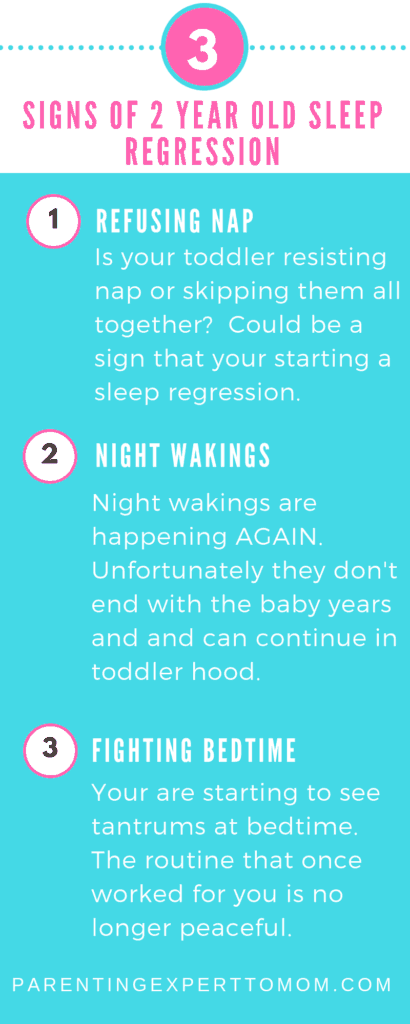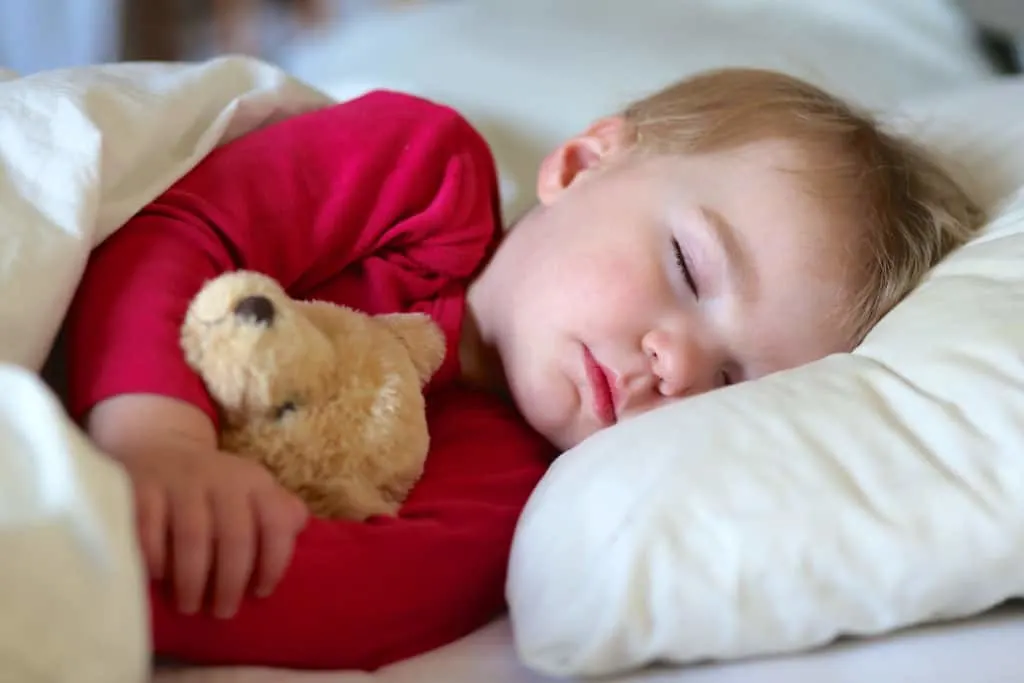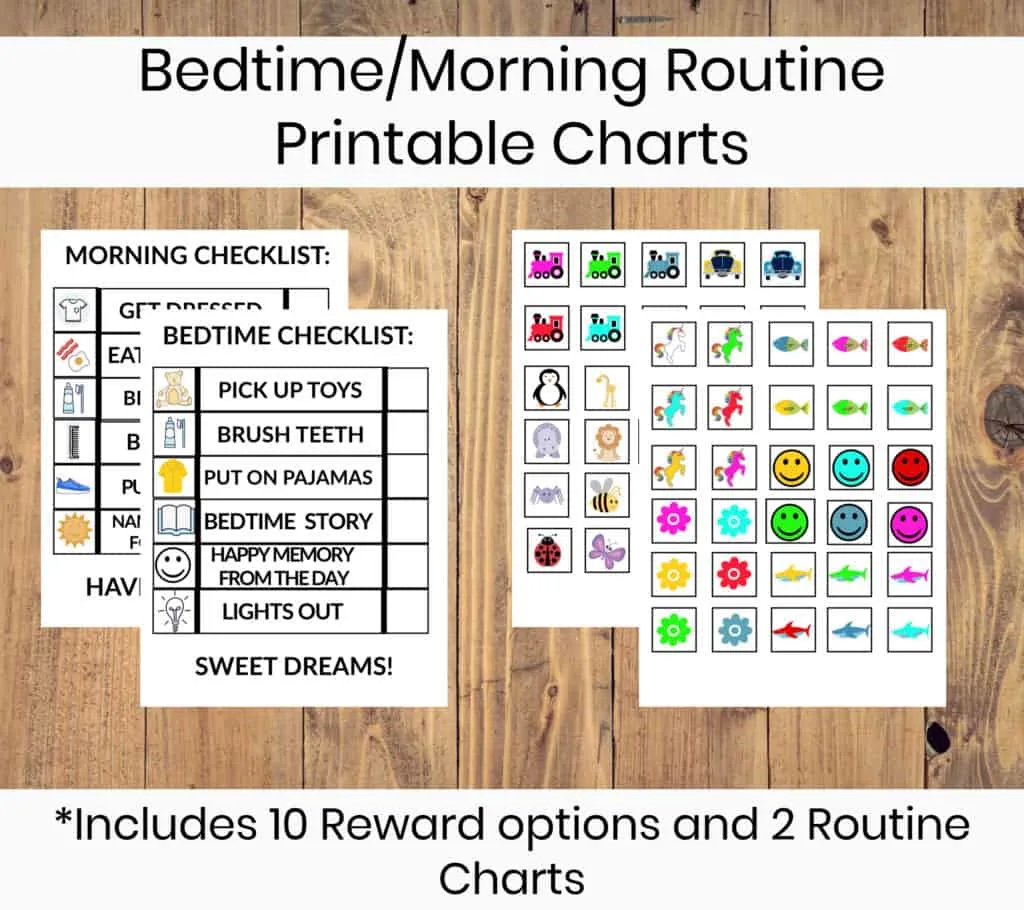Are you having a difficult time getting your toddler to go to bed in a peaceful way?
Are you seeing an increase in night wakings?
The sleep problems that your toddler is struggling with may be the dreaded 2-year sleep regression.
This is a problem I struggled with at my house for quite some time before seeking out help.
If you are looking for strategies on how to end toddler bedtime struggles then continue reading.
Bedtime Had Become a Power Struggle
Bedtime at our house was a complete disaster after my son turned 2.
We transitioned him at about 18 months to a big kid bed as he was crawling out of the crib.
Without the crib, it was very hard to get my toddler to stay in bed when it was time to go to sleep.
We had lots of screaming, tantrums and crying when bedtime rolled around.
The good news is we did survive the toddler sleep regression by using the strategies that you can find in this post.
In this post we will be going over:
- What is the toddler sleep regressions?
- What causes the two year old sleep regression?
- How long does the toddler sleep regression last?
- Toddler Sleep Regression Solutions
- How to Support Healthy Sleep Habits
- How to Help Your Child Fall Asleep
- When should you tranisition out of the crib?

(This post may contain affiliate links. To read our full disclosure policy click here.)
There are many different view points on whether melatonin is safe for young children and research is still being done.
You should speak with your doctor before administering melatonin to your child .
There could be many different reasons for why your 2 year old is waking during the night.
One common reason is because they are overtired.
You will want to make sure that bedtime is early enough so that your child does not become overtired. This is very important if they are no longer napping.
Just like in babies, developmental leaps could also be the cause of night wakings.
2 year olds also may experience night terrors which could cause night wakings as well.
There are many reasons a toddler could be crying at night.
They may be scared or lonely.
Sickness can sometimes hit during the night so they may have spiked a fever or are not feeling well.
If they do not seem to be awake, they may be experiencing a night terror.
If your toddler is screaming, talking, or crying at nighttime but does not seem “awake”. They may be having night terrors.
Pay attention to any triggers such as sickness or being overtired to see if there is a pattern.
What is the 2-Year-Old Sleep Regression?
It seems like every time I think I have this sleep thing figured out….a sleep regression hits.
We struggled with my son’s sleep when he was a baby, but around a year things calmed down and we were all getting some sleep.
Then around 18 months, he crawled out of his crib.
Yikes!
We moved him to a big bed that was on the floor so that he wouldn’t fall out.
I would not recommend transitioning a child out of their crib this young…but if they are crawling out..this is pretty much the only option because they need to be safe.
The transition went smoothly and we were pleasantly surprised.
He was taking a nice afternoon nap every day and sleeping about 12 hours a night. It was wonderful!
Then his second birthday happened. His perfect sleep routine ended quickly.

What causes the two-year sleep regression?
A sleep regression at 2 is very common and part of typical development.
There are many different things that can trigger a sleep regression.
Let’s take a look at a few of them.
Developmental Milestones Keep Your Toddler Awake
Have you ever learned something new or had a new experience that got you so excited you couldn’t sleep?
Toddlers are experiencing and learning new things ALL DAY and sometimes they just can’t stop which can lead to wake-ups and have an overall effect on toddler sleep.
Toddler developmental milestones continue to happen as your child ages.
You may remember wake-ups happening more often around those times when your little one was a baby working on new skills as well.
Right before they hit a big milestone (crawling, standing, etc.) they would suddenly stop sleeping.
The age of 2 comes with lots of big milestones.
- Large motor skills are becoming more refined
- New language skills such as understanding more words
- Language explosion may be happening when they start to say a lot of new words all of a sudden
- Potty Training
Read more about toddler development and milestones here.
You may notice that once your toddler gets through some of these milestones the wake-ups seem to magically disappear.
Teething: Does it ever end?
Teeth seem to really cause some little ones trouble during the night and can have an impact on toddler sleep.
If your toddler is getting in the last of their molars then this could trigger some issues.
Unfortunately, all children get their teeth at different times.
Usually, the first molars pop in around 12-17 months. The lower molars come in sometime between 24-36 months (Source.)
If your child is teething they may need some extra comfort.
You can ask your pediatrician what teething remedies would be best for your toddler to help with discomfort.

Separation Anxiety May Become Stronger
Your toddler is really starting to understand how the world works.
They may start to realize that they like to be near you and they don’t want to miss out on what’s going on.
They may also start to get scared or have fear when they are not with you.
When they were a baby you carried them around almost 24/7.
Now that they can walk and explore on their own they are spending less time attached to your hip.
With exploring new territory fears can arise.
Separation anxiety can become strong at different times and is unique to each child.
Major Changes Can Cause Sleep Disruptances
Did you move house recently?
Did they start at a new childcare or nursery school?
Are you expecting a new sibling?
All of these big changes can be possible causes of a change in sleep patterns.
When life changes happen know that it can cause a bump in the road when it comes to your toddler’s sleep but it should get back on track soon.
They Need Less Sleep
When your baby was a newborn they slept ALL DAY.
Then they turned into an infant and the awake time increased.
At one point your baby took three naps a day…then transitioned to two.
Are you noticing a pattern?
As your child gets older they need less sleep.
Toddler sleep is going to look different then when they were a baby.
Children from age 1-2 need somewhere between 11-14 hours of sleep in a 24 hour period including naps! (source)
Anytime your child starts to need less sleep it may take some time to adjust nap time and nighttime sleep.
They may skip some naps or fight naps.
Bedtime resistance starts up.
Unfortunately, you could even have some unwanted night wakings and an early morning or two.

2 Year Old Nap Regression
Is your two-year-old fighting their daytime nap like there is no tomorrow?
Even if your 2-year-old still needs a nap, they may act like they don’t.
Some children may drop their nap time at 2 although most children hang on to them till closer to age 3.
Try to keep naps consistent but if they do get missed, then bump up bedtime earlier so they are not so overtired.
Night Terrors or Nightmares May Be Starting
Is your toddler suddenly waking during the night screaming?
Do they talk in their sleep or seem restless during sleep?
These could be signs that your little one is having nightmares or night terrors.
My son experienced night terrors and it was no fun!
He would wake in the middle of the night and get out of bed.
Sometimes he would scream or yell things that didn’t make sense.
Signs of a Night Terror
- Yelling or screaming in sleep
- Not making sense
- Eyes are open wide
- Suddenly stops and falls back to sleep with out a reason
What should you do during a night terror?
The only thing you need to worry about is making sure they don’t get hurt.
If they are running or if it is possible that they could hurt themselves then you need to intervene.
If they are in a safe spot then it is best to just let it happen.
Night Terror Triggers
There may be certain things that trigger night terrors for your toddler.
For my son when he was overtired, sick, or had a very exciting day we could almost count on having one.
Keep a diary of when they occur and how long they last. Make sure to let your pediatrician know about them especially if you have concerns (source).
How long does the two year old sleep regression last?
For some children, it may only last for a few days. For others, it may be weeks.
All children are different and their sleep needs and changes are unique as well.
2 Year Old Sleep Regression Solutions

How to Get a Two-Year-Old to Sleep
There are a few different strategies you will want to try that can aid in getting your two-year-old to sleep.
All kids are different and what works for one may or may not work for another.
It may take some trial and error to find the best sleep solutions for your family.

Grab your FREE Milestone Guide HERE.
What is a good sleep routine for a 2-year-old?
Establish a Consistent Bedtime Routine
Although we had a “routine” for our toddler it was not clear enough and he often ended up running the show.
What worked best for us was to use a bedtime routine chart.
This was a way to set clear boundaries for our toddler and give him a visual reminder.
Visual prompts can be an EXCELLENT tool when working through routines.
When you think about it, as an adult we use them all the time.
Do you feel lost without a planner or a calendar?
Chances are your toddler might too.
How to Create a Bedtime Routine Chart

If you want to create a bedtime routine chart that is specific to your own child’s routine, I highly recommend it.
It does not need to be fancy, but here are some simple tips to keep in mind when creating it.
- Keep it short. Do not make a huge daunting bedtime checklist. I would focus on 6 things or fewer as your bedtime routine.
- Use pictures. You can draw stick people or take pictures of actual items in your house to create the chart. Chances are your child doesn’t read yet so pictures become necessary.
- Use stickers or stars to track your progress in the routine. This can be very motivating for little ones.
I did make a bedtime routine chart for my son and you can download the printable version here.
Another option would be to buy one (like this) that is already ready to go.
Using a 2-Year-Old Bedtime Routine Chart With Your Toddler
One of the big advantages of using a chart or visual reminder for your child is it ends the battle before it can begin.
The chart is now to blame for everything, not mom or dad.
Introduce the chart to your child by telling them these are the things we get to do before we go to bed.
Tell them how excited you are to do these things with them.
Let them pick out special stickers (I included lots of fun options in my set) or have them help you draw little stars using a fun marker as they accomplish each task.
This should not look like a punishment.
This should be a new fun part of getting ready for bed.
I would recommend reading through all the items on the list to start so your child knows what to expect.
As each item is accomplished a sticker or star is placed by the item to show it has been completed.
Use positive praise as your child completes each item.
MUST READ: How to Get Your Toddler to Listen Without Yelling
Use a Sleep Training Alarm Clock
Remember how we talked about how visual prompts can be so very helpful for little ones?
A sleep training alarm clock will use one color for “sleep” time and change to a different color when it is time to be awake.
This is a great thing to have for children who may wake up too early because they think it is time to get up.
This is the one we have for my son and he loves it.
Even if he does wake up a bit earlier than we like he will usually stay in his bed until it turns green.
We also use it at night as another visual reminder that it is time for bed.
This is helpful especially when it stays light until late in the evening and when the sun is up so early!
Be Patient and Consistent
If you haven’t had a set routine in the past it may take a while for your toddler to catch on.
Use the bedtime routine chart consistently and follow it EXACTLY so there is no confusion for your child.
They may not catch on the first few nights, but stick with it!
This will help you survive the two-year-old sleep regression.
Don’t forget to download the printable bedtime routine chart below!
If you are still having problems getting your toddler to sleep or stay asleep you can also check out the The Baby Sleep Site (click here) for more information on sleep.
Have a Consistent Sleep Routine and Appropriate Bedtime
Having an overtired child is the WORST!
A toddler not sleeping well can cause them to be cranky and unhappy.
Make sure you have a bedtime that is appropriate for your toddler.
For us that bedtime is somewhere between 6:45-7:45.
Not everyone can do that early of bedtime and it also depends on whether or not your toddler is napping.
You may have to adjust times to see what works best for your toddler.
Only move it 15 minutes earlier or later when adjusting the time.
Gradual changes are best!

Watch For Sleep Cues
Observe your toddler in the evening and watch for sleep cues.
This will help you figure out what bedtime is most appropriate.
If they are rubbing their eyes or laying on the floor they are probably overtired.
If they all of a sudden have a huge burst of energy and are bouncing off the walls…this also could be a sign they are overtired and you should consider an earlier bedtime.
Rest With Your Toddler
Are naps not working for your little one?
Is it getting to the point where the fight is not worth it?
Try to implement some rest time if possible if naps are not happening.
Give your toddler some books to look at while they rest or just encourage them to lay down for a bit.
See if they will cuddle with you on the couch.
Turn on a child audiobook (download one here) and listen to a story together.
My toddler started fighting naps hard at about 24 months and completely dropped them by 30 months.
I was sad when naps were over, but we moved up his bedtime and his sleep actually got better once we let go of naps.
However, many children still take naps when they are 3 or older…so hold onto them as long as you can!

Hold Off On Transitioning Out of the Crib
Should I get a toddler bed for my 2-year-old?
This is a common question that many parents have.
Do not transition your toddler out of the crib until you have to.
The longer you can wait the better.
If you transition them when they are older, chances are they will be more prepared for it.
They will understand why they are moving to a big bed and will most likely be excited.
Transitioning at 18 months was not an ideal time.
We had to as he became proficient at climbing out of the crib quickly and it was a safety hazard.
He was really too young to understand why we were moving into a big bed.
There were also more safety concerns as he could get up and leave his bed whenever he wanted during the night.
We ended up putting a queen-size mattress on the floor in his room.
We did this because I was pregnant with number 2 and didn’t want to use the crib that transitioned into a toddler bed as we would be needing the crib again soon.
Having a mattress on the floor worked well when transitioning at this age.
We still like it because there are nights when he still needs some extra snuggles and I have fallen asleep in their many times.
After searching the internet for ways to get my toddler to sleep I came across the Sleep Sense Program (Check it out here.)
This program lays out everything you need to know about how to establish good sleep habits for your toddler.
I highly recommend it to anyone having sleep issues with their child from birth to age 5.
You can grab your free sleep assessment HERE.
We now have a toddler who is asleep in his bed before 7:00 pm.
There is no screaming.
No crying.
No car rides!
Nighttime Fears: Make Sure Your Child Feels Safe
If they are getting scared at night make sure they have a way to comfort themselves.
Maybe it is a special blanket or a stuffed animal that makes them feel secure.
Are they scared of the dark?
I would recommend having the room as dark as possible.
Having room-darkening curtains (like these) can be very helpful for those bright mornings and evenings.
However, if your child is getting scared then you can use a small night light (like this.)
We are also a big fan of using a white noise machine to help create a calming environment.
If you enjoyed this post make sure to find me on Instagram for more parenting tips!
Related Posts You Will Enjoy
Toddler Activities for Screen Free Parenting
Top Non-Toy Gifts for Toddlers
What to Do When Stressed Out By Toddler Tantrums
5 Ways to Promote Positive Behaviors in Toddlers


Kayla O’Neill has a master’s degree in education as well as a bachelor’s degree in special education with an emphasis in early childhood education. She has been working as a developmental therapist with babies and toddlers in early intervention since 2012. She is also a mom with two young children.

Tia
Monday 24th of September 2018
Haha, I know first hand out hard this can be to deal with. Good luck to anyone out there!